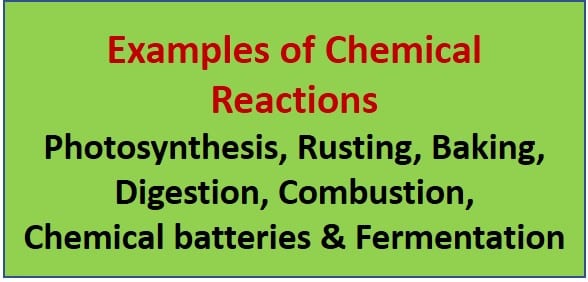Chemical reactions involve breaking chemical bonds between reactant molecules (particles) and establishing new bonds between atoms in product particles.
Examples of chemical reactions in everyday life include photosynthesis, rusting, baking, digestion, combustion, chemical batteries, fermentation, and washing with soap and water.

Table of Contents
What is a Chemical Reaction?
A chemical reaction occurs when one or more compounds, known as reactants, are changed into one or more distinct substances, known as products. Chemical elements or compounds are examples of substances. The constituent atoms of the reactants are rearranged in a chemical reaction, resulting in the formation of various substances as products. The number of atoms is the same before and after the chemical transformation, but the number of molecules is different.
Examples of Chemical Reactions in Everyday Life
- Cooking
- Photosynthesis
- Cellular respiration
- Corrosion
- Digestion
- Fireworks
- Bleaching
A Closer Look at Examples of Chemical Reactions
Cooking
Chemical reactions are beneficial in the kitchen and aid in the enhancement of food flavor.
Cooking and chemistry share a lot of similarities.
The reactants are the ingredients that begin a chemical reaction.
These react with one another to generate the product, which is an entirely new substance.
The properties of the products are vastly different from those of the reactants.
Cakes are harder and have a superior flavor than individual cookies.
Photosynthesis
Photosynthesis is represented by a chemical reaction.
6CO2 + 6H2O = C6H12O6 + 6O2.
This signifies that light energy captured by chlorophyll (implied by the arrow) converts the reactants, six carbon dioxide molecules, and six water molecules, into a sugar molecule and six oxygen molecules, the products.
Cellular Respiration
Cellular respiration is a set of metabolic reactions and processes that take place in the cells of organisms to convert chemical energy from oxygen molecules or nutrients into adenosine triphosphate (ATP), and then release waste products.
Oxidation
An oxidation-reduction (redox) reaction is a type of chemical reaction in which two species exchange electrons. Any chemical reaction in which the oxidation number of a molecule, atom, or ion changes by gaining or losing an electron is known as an oxidation-reduction process.
Electrochemistry
The study of chemical reactions that cause electrons to move is known as electrochemistry. The movement of electrons is known as electricity, and it can be generated by moving electrons from one element to another in an oxidation-reduction (“redox”) reaction.
Digestion
Food digestion is a combination of mechanical and chemical processes. Large food particles are broken down into smaller components that can be absorbed more easily into the bloodstream during digestion.
Carbohydrates are burned during bodily processes to produce energy, giving out carbon dioxide and water.
Fireworks
Chemical reactions involving a few critical components, such as a fuel source (typically charcoal-based black powder), an oxidizer (oxygen-producing compounds such as nitrates and chlorates), and a color-producing chemical mixture make fireworks.
The oxidizer releases energy by breaking down the chemical bonds in the fuel. See more on the topic of carbon emissions.
Corrosion
Corrosion is the degradation of a substance (typically a metal) or its qualities as a result of a reaction with its surroundings. This might result in serious damage to your building or application, which may be quite costly to repair.
Corrosion happens when a gas or liquid chemically attacks an exposed surface, usually a metal, and is accelerated by heat, acids, and salts.
Reduction-oxidation (redox) reactions are the chemical events that occur during corrosion.
Such reactions necessitate the use of an oxidized (metal) and a reduced species of material (the oxidizing agent).
As a result, the entire reaction can be broken down into two parts: oxidation and reduction.
Bleaching
Bleaching, or the removal of natural color from fabric, such as the tan of linen, is usually done using chemicals that are chosen based on the chemical composition of the fiber.
Bleach works by releasing oxygen molecules through an oxidation process. Bleach releases oxygen molecules, which destroy chromophores’ chemical connections. The chromophore molecules that have changed either reflect no color or a color that is not visible in the visible spectrum.
Important Links
Hydrogen Bond| Definition & Easy Explanation
Concentration gradient
Atmospheric Pressure
Perchloric Acid| Is It Super Acid?
Sulfurous Acid Formula & Lewis Structure
Summary
This article explains the definition of chemical reactions and examples of chemical reactions in daily life.
We can understand and describe how the natural world works by watching chemical interactions. Chemical reactions transform food into fuel for your body, cause pyrotechnics to burst, change the texture of food when cooked, remove filth from soap, and much more.
Frequently Asked Questions (FAQs)
Some of the frequently asked questions are listed below:
1. What is a Chemical reaction definition?
A chemical reaction is defined as the transformation of one substance into another with a different chemical identity.
Physical phenomena such as the emission of heat and light, the development of a precipitate, the development of gas, or a color change are generally accompanying it.
2. Examples of chemical reactions in living things?
In the human body, catabolic reactions break down molecules into smaller pieces and release energy. The breakdown of glucose during cellular respiration is an example of a catabolic reaction, which releases energy that cells require to carry out life functions.
3. What is rusting of iron?
Rusting is a chemical reaction that requires iron, water, and oxygen to form.
Despite the fact that it is a complicated process, the chemical equation is 4Fe + 3O2 + 6H2O 4Fe(OH)3.
Some of the examples of chemical reactions are listed below:
- Burning wood.
- Souring milk.
- Mixing acid and base.
- Digesting food.
- Cooking an egg.
- Heating sugar to form caramel.
- Baking a cake.
- Rusting of iron.
Burning, frying, rusting, and rotting are examples of chemical changes. Boiling, melting, freezing, and shredding are examples of physical changes. Many physical changes can be reversed if enough energy is provided.
Sublimation is the transformation of a solid into a gaseous state without passing through the liquid state. It does not involve a chemical reaction. It is a physical change.
It is a solid-to-gas transition.
Important Links
- BCl3 Lewis Structure in four simple steps - November 1, 2023
- PH3 Lewis Structure in four simple steps - October 8, 2023
- PF3 Lewis structure in four simple steps - September 24, 2023


